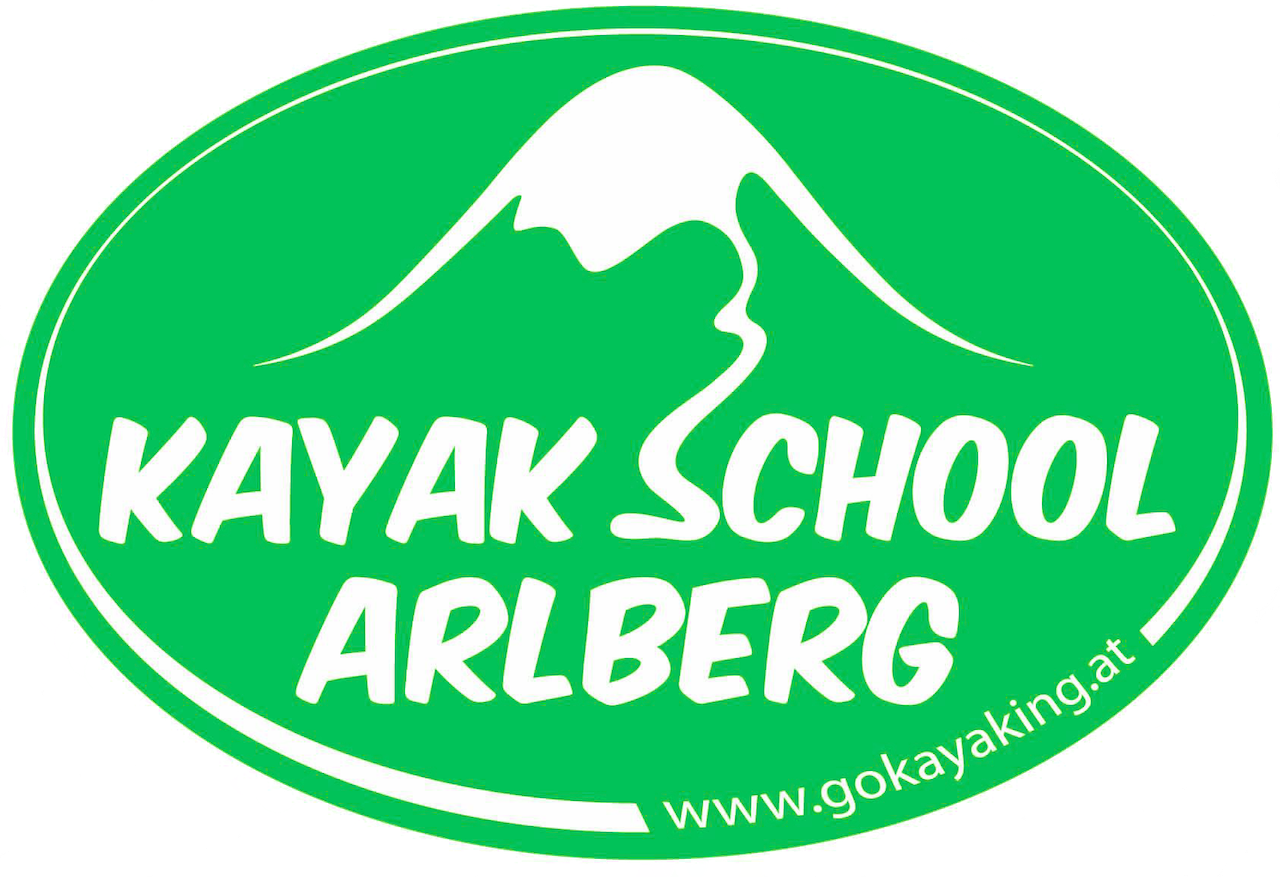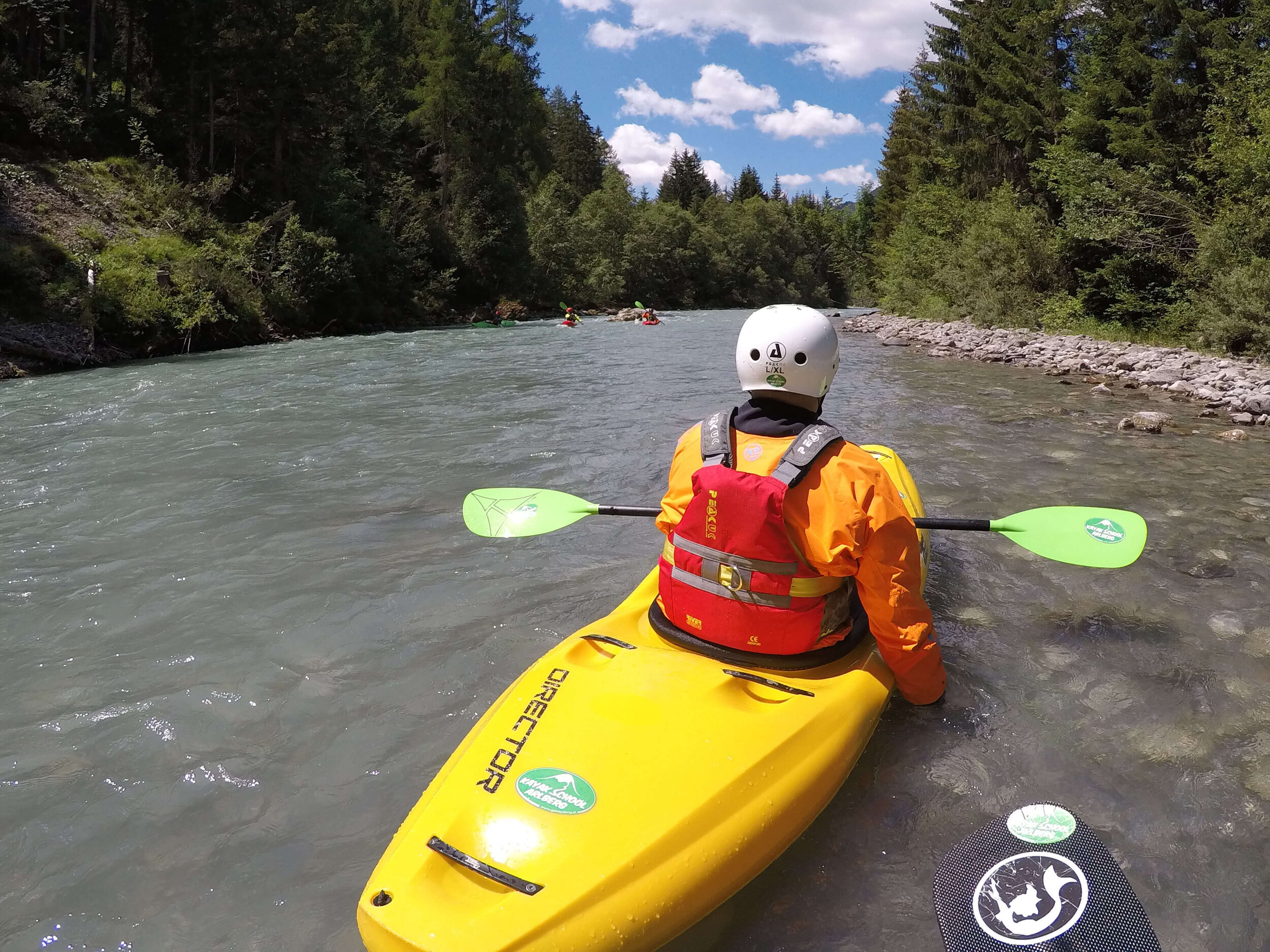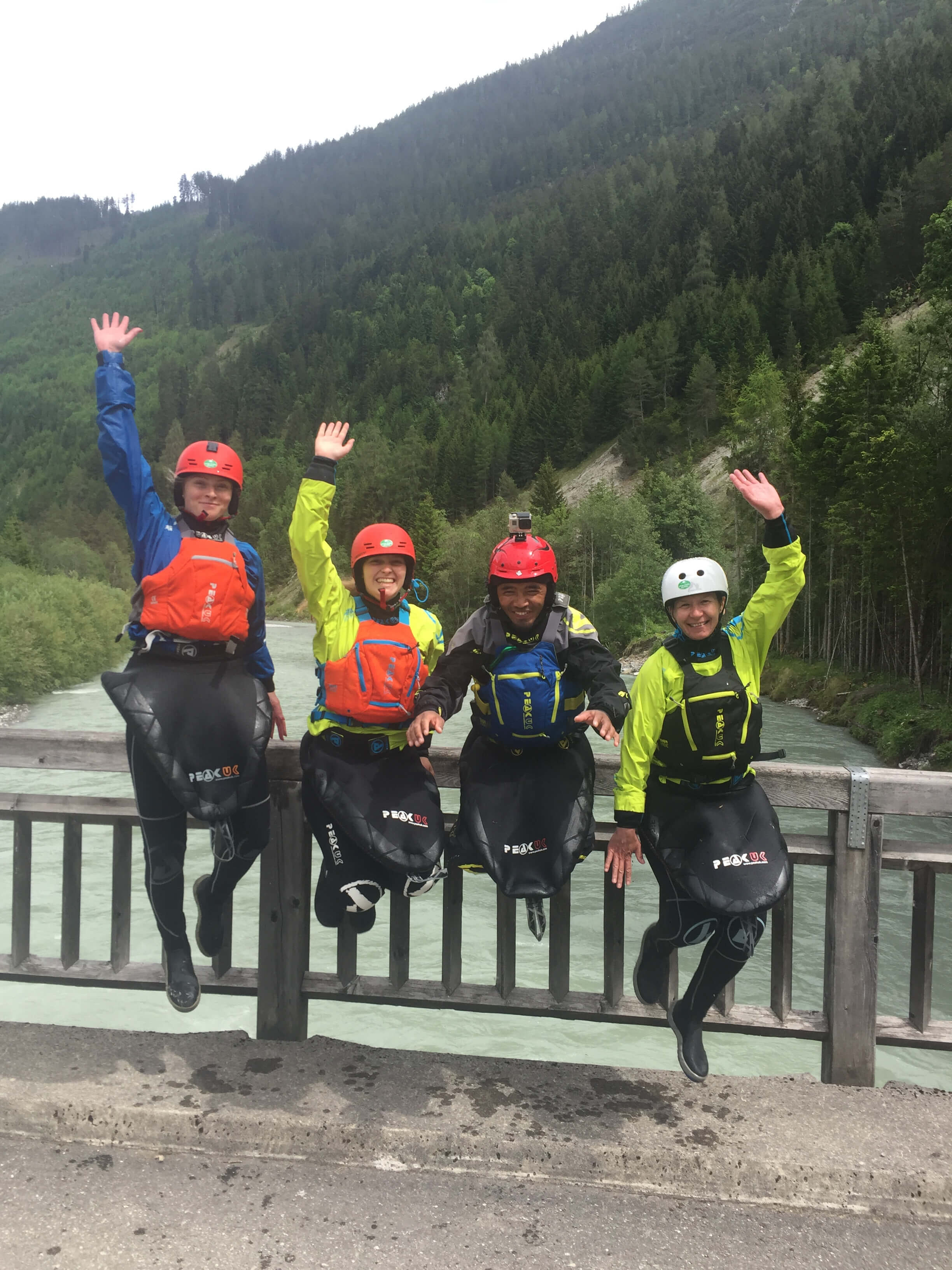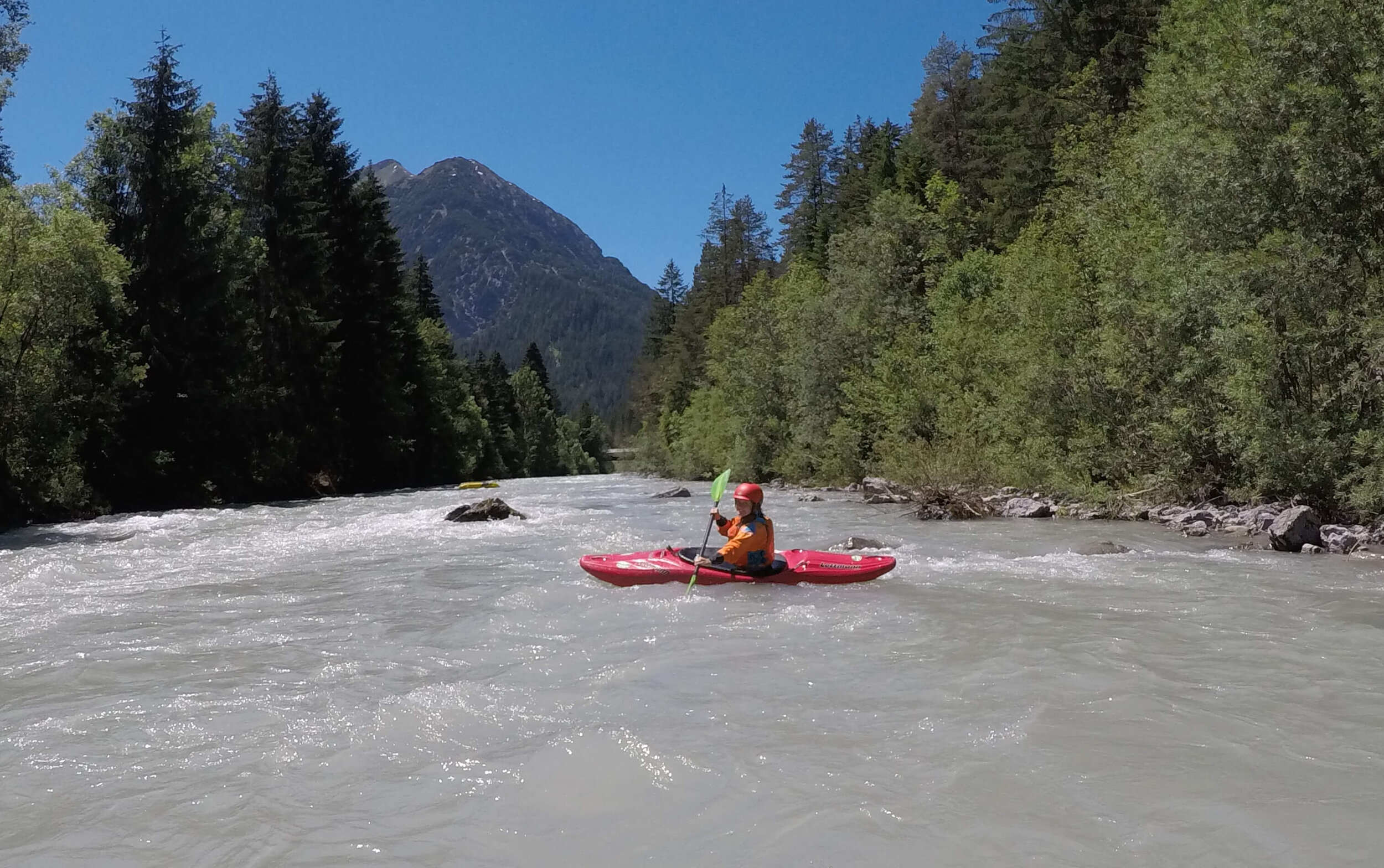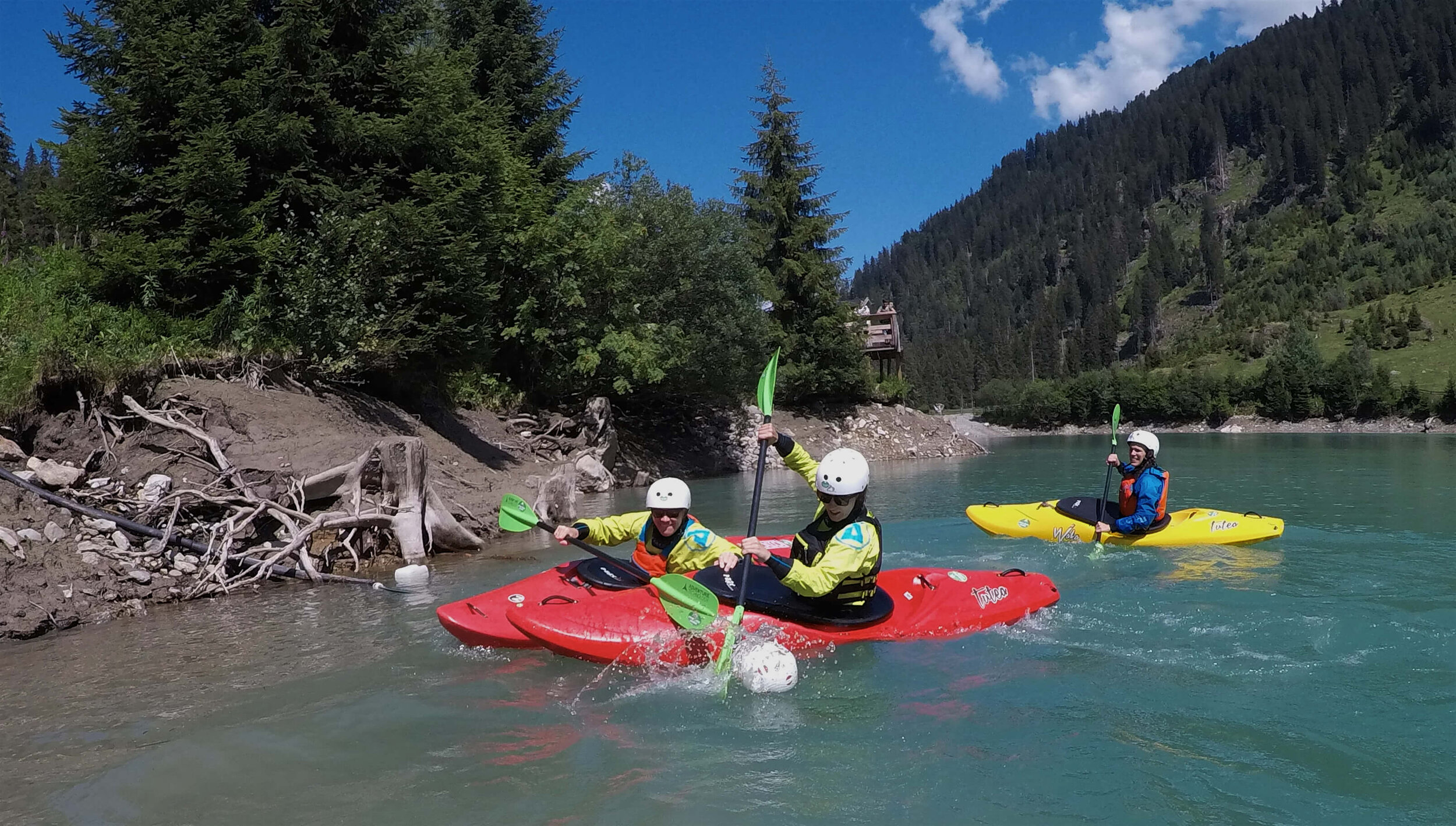Learn How to Kayak: everything you need to know
There are many options or paths to learn to kayak. Be it a quick taster session to see if it is something for you, a weekend course or a 3-4 day more technique based course. However, spending a week in a kayak on both a lake and on a river will give you the perfect foundation and best way to learn this amazing sport! Without doubt time spent in a kayak in the ideal environment with the correct equipment and a fully qualified instructor is by far the best route to becoming a dynamic and pro-active modern style of whitewater kayaker! It is these all important pieces that make sure you get the best out of your holiday and time on the river. Plus with a safe feeling you can focus on learning new skills and techniques.
Instructors
Without a doubt you should be asking what qualifications (in some cases if any) do the Instructors possess! Are they a club based qualification for volunteers or are they awarded by a Governing body which sets a minimum standard and can be used professionally? Of course it is not just the qualification you should be asking about. How much experience have the instructors or coaches got? Have they just kayaked on their home rivers or have they spent time working around the world in different countries, cultures and environments? Also how good are their personal techniques, are the instructors looking to improve themselves or are they just set in their ways of kayaking or instructing. Of course different continents and countries have different ways of kayaking and if your kayak instructor has kayaked and taught in various countries this can have a huge advantage of bringing modern and different techniques to the course.
Finally how much do they love the sport of kayaking? When they have days off do they go kayaking, do they travel to other regions, countries and continents to kayak? You will be surprised how many instructors just do it as a job. Finding an instructor who has a love for kayaking is amazing! Their love for the sport is infectious and this can be seen throughout any course they instruct, coach or teach on.
Equipment
Equipment has a huge impact to your experience learning to kayak. Over the past 5-10 years there has been a massive improvement in kayaking equipment so much so that our techniques and tactics of whitewater kayaking have also had to evolve. Gone are the days (you would hope!) of extremely long and rounded kayaks with no edges, or outfitting and heavy paddles. Instead we have modern kayaks that are stable, easy to manoeuvre and perform unbelievably well in whitewater. Having a good range of kayaks from various manufacturers give you the best opportunity to find the right kayak for your body size, shape and skill.
Paddles are similar. Do you need a 90 degree feather on your paddle? Surely as a beginner it is more important to learn to kayak forwards dynamically in a straight line than worrying about whether I have bent my wrist into such a strange and unnatural position to gain a full stroke on the blade?
Apparel plays another important roll in our learning and enjoyment of kayaking. Do you want to be wearing equipment designed for rafting where the neoprene rubs under your arms, the Personal Flotation Device (PFD) or Buoyancy Aid has the volume in the wrong place and you end up with the thing nearly covering your head and of course a helmet with substandard padding or outfitting as it is primary use is again for rafting!
Equipment that is designed and made for kayaking gives you that great freedom of movement around your shoulders, arms and back. If you require the use of neoprene then either trousers (combined with a thermal top) or long john style will be the best as it will keep you warm, gives you the freedom of movement you require and of course protects you if you make a wet exit leaving the kayak. The jacket, cag, spray top should be well sealed around the wrists and waist to make sure no water enters the kayak and a nice neoprene neck cone makes life a little more comfortable as a beginner compared to a rubber neck seal. Spraydecks should be neoprene to make a great fit around the rim of the kayaks cockpit and if the youngsters cannot open a neoprene deck then it should not be used! Neoprene booties are a must, they protect your ankles when you are walking along the river bank and keep you feet warm if the water is cold. The PFD or BA fits you like a glove and feels a part of your body, the helmet has been designed for kayaking with the correct amount of protection and padding options to make it stay on your head and not wobble around and finally what is just as important….do I look like a kayaker? That’s Learning to Kayak right, you maybe on the lake or a niece piece of Class 2 whitewater but you can still look like those kayakers on social media running big rapids and drops!!
Location
Choosing your location is an extremely important decision to make when learning to kayak. Are you going to kayak in the Spring, Summer or Autumn? A lake is the best place to gain your balance and learn the fundamental skills of kayaking. Having clean water will get rid of the nerves of falling in or exiting the kayak. Water temperature helps but more important is the equipment that can keep you warm and dry. Having a variety of rivers at your location also helps immensely. If you are on an Intensive Kayaking Course having rivers with different water volumes, gradient, waves and rapids is a sure way to make a solid foundation of river skills and techniques. Of course every river has its season so finding out how long the rivers run for and optimum levels for learning and gaining experience is hugely important.
Also there is something special about kayaking whitewater in stunning scenery that makes the overall experience all that more enjoyable.
The Kayak Beginner Course
The first day is all about Gaining Confidence on the lake by getting accustomed to the kayaks such as working on balance and stability. Learning the Basics such as dynamic forward paddling is a fundamental skill and one that you will be able to develop throughout your time in a kayak. Correcting and turning the kayak with forward strokes is a necessity not just on the lake but also on whitewater.
By the end of the day, if you have not flipped over then you should perform a wet exit. With another explanation from your instructor of what is required and when then you can perform a clean safe exit from an upturned kayak.
One word is mentioned quite a few times - the Lake. Learning to kayak is made far more easier for Beginners if they are on a lake. It can take a while of patience, skill and good instruction to get you kayaking in a straight line! If you are on a piece of moving water it can take longer to learn to paddle in a straight line which means your confidence will not be high causing wobbles, getting annoyed at not having sufficient control or flipping over!
The second day would consist of Learning to edge the kayak - great for balance, control of line and direction. A good brace stroke can prevent you from capsizing and though it will take time to make it a quick reaction, time should be spent on the lake working on this technique. Basic river theory is extremely important. If features such as eddy’s, waves, holes, tongues and sayings such as river left, river right, class 2 sound daunting then on dry land is the place to start! We like to draw features in the sand and use our little smurf to explain everything nice and methodically.
Sometime on the second day you would expect to go to a nice piece of mellow moving water, what we would call Class 1. Here you can put your newly learnt skills from the lake to the test and by working on the fundamental river techniques such as moving from one side of the river to the other (ferry gliding), carving a kayak (turning) and breaking in and out (either going into the rivers current or exiting it).
With a mellow stretch of whitewater you get the time to understand the way of the river and its strange currents plus it is very forgiving letting you make mistakes a long the way. Try to learn these techniques on faster whitewater makes the learning process all that much longer and again will test your balance and maybe your patience! This generally where most Beginners decide whether kayaking is for them and so the choice of your first whitewater river is HUGELY important! What your instructor may think is mellow and easy can be challenging for you where frustration hangs heavy just like the negative impact the sport makes on you. Again a little more research and questions you can ask the Kayak School or Instructor about the course is so important.
A 2 day course is pretty much something to see if whitewater kayaking is for you!
On day 3 you would expect to head to a Class 2 river, where there are more waves to paddle through and small rapids to kayak. Throughout the day expect to work on your eddy techniques and again more dynamic ferry gliding from one side of the river to the other. Learning to Kayak If you can make a journey from day 3 onwards, spending all day on the river. Having lunch by the side of the river, enjoying the weather and of course admiring the stunning mountain scenery makes for a truly epic day!
A 3 day course will give you a good start and foundation for the sport. Joining an active whitewater club after a Beginners course is highly recommended.
A 4 day course would usually see you with an extra day on a Class 2 river and with more river kilometres comes confidence in your technique and abilities.
A week of instruction on something equivalent to our Zero to Hero Kayaking Course will see you include the eskimo roll in a warm lake or swimming pool and then putting it into a whitewater scenario. With various styles, characters of rivers and whitewater to kayak you will have a solid foundation and a competent Class 2 kayaker who has had experience of Class 3 whitewater! Taking a one week Beginners Kayaking Course is the perfect way to become a competent whitewater kayaker in a short time!
These are our top tips for learning to kayak, let us know your thoughts and to find out more information about learning to kayak in Austria then check out our Beginner Course.
